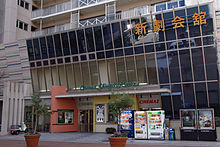Japanese movie
| Cinema of Japan | |
|---|---|

Shingeki-kaikan (now cinema KOBE) in Kobe
|
|
| No. of screens | 3,437 (2015) |
| • Per capita | 2.9 per 100,000 (2011) |
| Main distributors |
Toho (32.6%) Walt Disney (10.7%) Toei Company (8.9%) |
| Number of admissions (2015) | |
| Total | 166,630,000 |
| Gross box office (2015) | |
| Total | ¥217.119 billion (US$1.8 billion) |
| National films | ¥120.367 billion (55.4%) |
The cinema of Japan (日本映画 Nihon eiga, also known domestically as 邦画 hōga, "domestic cinema") has a history that spans more than 100 years. Japan has one of the oldest and largest film industries in the world; as of 2010, it was the fourth largest by number of feature films produced. In 2011 Japan produced 411 feature films that earned 54.9% of a box office total of US$2.338 billion. Movies have been produced in Japan since 1897, when the first foreign cameramen arrived. In a Sight & Sound list of the best films produced in Asia, Japanese works made up eight of the top 12, with Tokyo Story (1953) ranked number one. Japan has won the Academy Award for the Best Foreign Language Film four times, once again more than any other Asian country.
The kinetoscope, first shown commercially by Thomas Edison in the United States in 1894, was first shown in Japan in November 1896. The Vitascope and the Lumière Brothers' Cinematograph were first presented in Japan in early 1897, by businessmen such as Inabata Katsutaro. Lumière cameramen were the first to shoot films in Japan. Moving pictures, however, were not an entirely new experience for the Japanese because of their rich tradition of pre-cinematic devices such as gentō (utsushi-e) or the magic lantern. The first successful Japanese film in late 1897 showed sights in Tokyo.
In 1898 some ghost films were made, the Shirō Asano shorts Bake Jizo (Jizo the Spook / 化け地蔵) and Shinin no sosei (Resurrection of a Corpse). The first documentary, the short Geisha no teodori (芸者の手踊り), was made in June 1899. Tsunekichi Shibata made a number of early films, including Momijigari, an 1899 record of two famous actors performing a scene from a well-known kabuki play. Early films were influenced by traditional theater – for example, kabuki and bunraku.
...
Wikipedia
